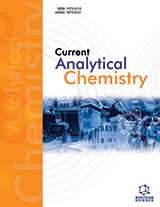
Abstract
Activatable fluorescent probes share the unique feature of being turned on only under specific conditions: they are "silent" when not interacting with a specific target protein, microenvironment, or reactive species. Several activatable fluorescence probes have demonstrated their potential in cell biology study, disease study and diagnosis, and even in the rapidly expanding field of image-guided surgery. In this review, we will summarize progress in the design of activatable probes and their application in studying cell biology or in optical imaging. Some of the most effective examples of activatable fluorescent probes will be presented and their application will be discussed.
Keywords: Activatable fluorescent probes, cancer imaging, FRET, metal ions, neurodegenerative diseases, optical imaging, photon-induced electron transfer
Current Medicinal Chemistry
Title:Activatable Fluorescent Probes: A New Concept in Optical Molecular Imaging
Volume: 19 Issue: 28
Author(s): E. Lacivita, M. Leopoldo, F. Berardi, N. A. Colabufo and R. Perrone
Affiliation:
Keywords: Activatable fluorescent probes, cancer imaging, FRET, metal ions, neurodegenerative diseases, optical imaging, photon-induced electron transfer
Abstract: Activatable fluorescent probes share the unique feature of being turned on only under specific conditions: they are "silent" when not interacting with a specific target protein, microenvironment, or reactive species. Several activatable fluorescence probes have demonstrated their potential in cell biology study, disease study and diagnosis, and even in the rapidly expanding field of image-guided surgery. In this review, we will summarize progress in the design of activatable probes and their application in studying cell biology or in optical imaging. Some of the most effective examples of activatable fluorescent probes will be presented and their application will be discussed.
Export Options
About this article
Cite this article as:
Lacivita E., Leopoldo M., Berardi F., A. Colabufo N. and Perrone R., Activatable Fluorescent Probes: A New Concept in Optical Molecular Imaging, Current Medicinal Chemistry 2012; 19 (28) . https://dx.doi.org/10.2174/092986712803341511
| DOI https://dx.doi.org/10.2174/092986712803341511 |
Print ISSN 0929-8673 |
| Publisher Name Bentham Science Publisher |
Online ISSN 1875-533X |
Call for Papers in Thematic Issues
Advances in Medicinal Chemistry: From Cancer to Chronic Diseases.
The broad spectrum of the issue will provide a comprehensive overview of emerging trends, novel therapeutic interventions, and translational insights that impact modern medicine. The primary focus will be diseases of global concern, including cancer, chronic pain, metabolic disorders, and autoimmune conditions, providing a broad overview of the advancements in ...read more
Approaches to the Treatment of Chronic Inflammation
Chronic inflammation is a hallmark of numerous diseases, significantly impacting global health. Although chronic inflammation is a hot topic, not much has been written about approaches to its treatment. This thematic issue aims to showcase the latest advancements in chronic inflammation treatment and foster discussion on future directions in this ...read more
Cellular and Molecular Mechanisms of Non-Infectious Inflammatory Diseases: Focus on Clinical Implications
The Special Issue covers the results of the studies on cellular and molecular mechanisms of non-infectious inflammatory diseases, in particular, autoimmune rheumatic diseases, atherosclerotic cardiovascular disease and other age-related disorders such as type II diabetes, cancer, neurodegenerative disorders, etc. Review and research articles as well as methodology papers that summarize ...read more
Chalcogen-modified nucleic acid analogues
Chalcogen-modified nucleosides, nucleotides and oligonucleotides have been of great interest to scientific research for many years. The replacement of oxygen in the nucleobase, sugar or phosphate backbone by chalcogen atoms (sulfur, selenium, tellurium) gives these biomolecules unique properties resulting from their altered physical and chemical properties. The continuing interest in ...read more
 45
45
- Author Guidelines
- Graphical Abstracts
- Fabricating and Stating False Information
- Research Misconduct
- Post Publication Discussions and Corrections
- Publishing Ethics and Rectitude
- Increase Visibility of Your Article
- Archiving Policies
- Peer Review Workflow
- Order Your Article Before Print
- Promote Your Article
- Manuscript Transfer Facility
- Editorial Policies
- Allegations from Whistleblowers
- Announcements























